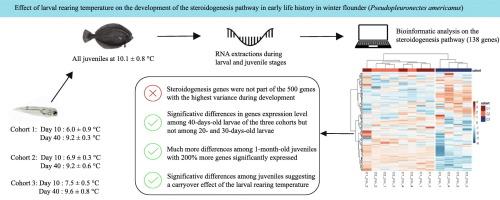Effect of larval rearing temperature on steroidogenesis pathway development in winter flounder (Pseudopleuronectes americanus) early life history
IF 2.1
3区 生物学
Q4 BIOCHEMISTRY & MOLECULAR BIOLOGY
Comparative Biochemistry and Physiology A-Molecular & Integrative Physiology
Pub Date : 2024-10-28
DOI:10.1016/j.cbpa.2024.111770
引用次数: 0
Abstract
Winter flounder (Pseudopleuronectes americanus) is a North Atlantic flatfish that inhabits cold-water environments already affected by global warming. Flatfishes are particularly sensitive during their juvenile stage to a phenomenon known as temperature-dependent sex determination (TSD). In this study, we hypothesized that many genes involved in the steroidogenesis pathway are already expressed at the larval stage in winter flounder and that temperature conditions may influence this pathway prior to the juvenile stage, which is usually considered the TSD-sensitive period. We also hypothesized that temperature effects on the steroidogenesis pathway may carry over from the larval to the juvenile stage. We surveyed three cohorts issued from three different spawning events during spring. Rearing temperature and salinity conditions followed seasonal conditions in the St. Lawrence Estuary (Québec, Canada). As a result, cohorts were exposed to different temperature regimes during egg and larval development. Once metamorphosis occurred, all juveniles were held at a stable temperature of 10.1 ± 0.8 °C. Larvae were sampled at 20, 30, and, 40 days post-hatching and juveniles at one and two months post-metamorphosis. RNA was extracted from these individuals and then sequenced. Transcriptome analysis showed clear differentiation between larvae and juveniles. Gene expression patterns showed that the steroidogenesis pathway, including genes involved in gonadal differentiation, was influenced by temperature during larval development, which indicates that sexual determination at the cellular level is an early process in winter flounder development. Carry-over effects of larval rearing temperature conditions were present at the juvenile stage, with an increased number of genes involved in the steroidogenesis pathway being affected. Altogether, our study highlights the important role of larval development and temperature exposure on the transcriptome of winter flounder.

幼体饲养温度对冬鲽(Pseudopleuronectes americanus)早期生活史中类固醇生成途径发育的影响
冬季比目鱼(Pseudopleuronectes americanus)是北大西洋的一种比目鱼,栖息在已经受到全球变暖影响的冷水环境中。比目鱼在幼鱼阶段对温度依赖性决定性别(TSD)现象特别敏感。在这项研究中,我们假设许多参与类固醇生成途径的基因在冬季比目鱼的幼鱼阶段就已经表达,而温度条件可能会在通常被认为是 TSD 敏感期的幼鱼阶段之前影响这一途径。我们还假设,温度对类固醇生成途径的影响可能会从幼鱼阶段延续到幼鱼阶段。我们调查了春季三次不同产卵活动产生的三组鱼群。饲养温度和盐度条件与圣劳伦斯河口(加拿大魁北克省)的季节条件一致。因此,在卵和幼虫发育期间,各组群暴露在不同的温度条件下。一旦发生变态,所有幼体均保持在 10.1 ± 0.8 °C 的稳定温度下。幼虫在孵化后 20 天、30 天和 40 天采样,幼体在变态后 1 个月和 2 个月采样。从这些个体中提取 RNA,然后进行测序。转录组分析表明,幼虫和幼体之间存在明显的差异。基因表达模式显示,类固醇生成途径,包括参与性腺分化的基因,在幼体发育过程中受到温度的影响,这表明细胞水平的性决定是冬季鲽鱼发育的早期过程。幼体饲养温度条件对幼体阶段也有影响,受影响的类固醇生成途径基因数量增加。总之,我们的研究强调了幼体发育和温度暴露对冬鲽转录组的重要作用。
本文章由计算机程序翻译,如有差异,请以英文原文为准。
求助全文
约1分钟内获得全文
求助全文
来源期刊
CiteScore
5.00
自引率
4.30%
发文量
155
审稿时长
3 months
期刊介绍:
Part A: Molecular & Integrative Physiology of Comparative Biochemistry and Physiology. This journal covers molecular, cellular, integrative, and ecological physiology. Topics include bioenergetics, circulation, development, excretion, ion regulation, endocrinology, neurobiology, nutrition, respiration, and thermal biology. Study on regulatory mechanisms at any level of organization such as signal transduction and cellular interaction and control of behavior are also published.

 求助内容:
求助内容: 应助结果提醒方式:
应助结果提醒方式:


